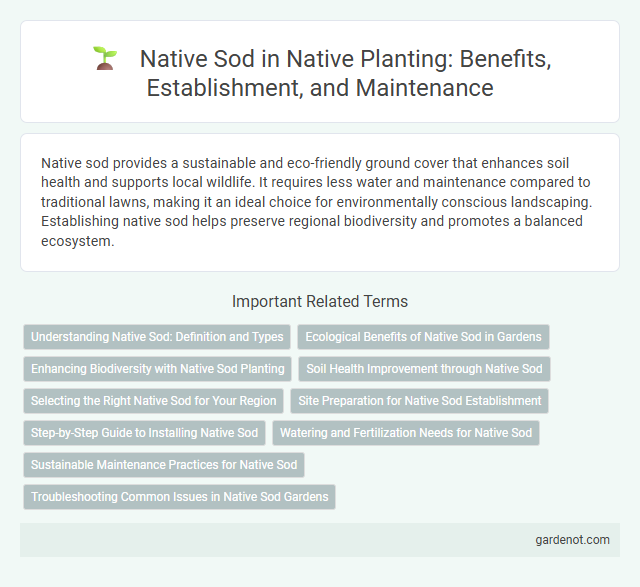Native sod provides a sustainable and eco-friendly ground cover that enhances soil health and supports local wildlife. It requires less water and maintenance compared to traditional lawns, making it an ideal choice for environmentally conscious landscaping. Establishing native sod helps preserve regional biodiversity and promotes a balanced ecosystem.
Understanding Native Sod: Definition and Types
Native sod consists of natural grass and soil layers harvested from local ecosystems, promoting biodiversity and soil health. Common types include prairie sod, meadow sod, and wetlands sod, each adapted to specific regional climates and native plant species. Selecting the appropriate native sod supports sustainable landscaping, reduces water usage, and enhances habitat restoration efforts.
Ecological Benefits of Native Sod in Gardens
Native sod enhances garden ecosystems by promoting biodiversity and providing habitat for local wildlife, including pollinators and beneficial insects. It improves soil health through natural root systems that prevent erosion and increase water retention, reducing the need for irrigation. By using native sod, gardens support resilient landscapes that adapt to regional climate conditions while minimizing chemical inputs and maintenance.
Enhancing Biodiversity with Native Sod Planting
Planting native sod significantly enhances biodiversity by providing habitat and food sources for local wildlife, including pollinators such as bees and butterflies. Native sod supports soil health through deep root systems that improve water infiltration and reduce erosion, promoting a balanced ecosystem. This sustainable landscaping choice reduces the need for chemical fertilizers and irrigation, fostering a resilient environment aligned with regional ecology.
Soil Health Improvement through Native Sod
Native sod enhances soil health by promoting microbial diversity and increasing organic matter content, which improves soil structure and nutrient cycling. Its deep root systems prevent erosion and facilitate water infiltration, reducing runoff and enhancing moisture retention. Establishing native sod supports long-term soil fertility and ecosystem resilience by fostering a balanced soil microbiome and natural nutrient dynamics.
Selecting the Right Native Sod for Your Region
Selecting the right native sod for your region involves analyzing local soil conditions, climate, and native plant species to ensure sustainability and vibrant growth. Opt for sod that includes native grasses such as buffalo grass in arid areas or fescue varieties in cooler zones to improve drought resistance and reduce maintenance. Consulting regional extension services or native plant societies can provide valuable insights for sourcing high-quality, ecologically compatible native sod that supports local biodiversity.
Site Preparation for Native Sod Establishment
Proper site preparation for native sod establishment involves thorough soil testing and amendment to ensure optimal nutrient balance and pH levels suited for indigenous grass species. Removal of existing vegetation, debris, and compaction through tilling or aeration promotes healthy root growth and sod integration. Final grading and moisture management create a stable environment necessary for native sod to thrive and establish strong, resilient turf.
Step-by-Step Guide to Installing Native Sod
Installing native sod begins with soil preparation, including removing existing grass, tilling the soil, and adding organic matter to improve nutrient content and drainage. Lay the native sod pieces tightly together in a staggered pattern, ensuring full contact with the soil to promote root growth and prevent gaps. Water the sod thoroughly immediately after installation and maintain consistent moisture for at least two weeks to support successful establishment and healthy growth.
Watering and Fertilization Needs for Native Sod
Native sod requires minimal watering compared to traditional turf, thriving primarily on natural rainfall once established, which conserves water resources and reduces maintenance. Fertilization needs are low since native sod species are adapted to local soil conditions, benefiting from periodic applications of slow-release, organic fertilizers to promote healthy growth. Proper watering schedules and targeted fertilization enhance root development, ensuring the native sod remains resilient and drought-tolerant.
Sustainable Maintenance Practices for Native Sod
Sustainable maintenance practices for native sod emphasize minimal water use, promoting deep root growth to enhance drought resistance and soil health. Utilizing organic fertilizers and integrated pest management reduces chemical inputs, supporting biodiversity and long-term ecosystem balance. Regular mowing at higher heights preserves turf vigor and encourages beneficial microbial activity in native sod environments.
Troubleshooting Common Issues in Native Sod Gardens
Troubleshooting common issues in native sod gardens involves addressing problems such as patchy growth, weed invasion, and poor soil drainage. Implementing proper soil preparation, regular watering schedules, and selecting region-appropriate native grass species can significantly reduce these challenges. Monitoring for pests and diseases specific to native sod, along with timely aeration, ensures a healthy, resilient lawn ecosystem.
Native sod Infographic

 gardenot.com
gardenot.com